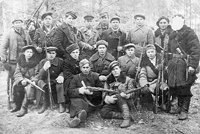By Leyna Krow, Assistant Editor, JTNews
Before previews for the film Defiance started popping up in movie theaters around the country, most Americans had never heard of the Bielski partisans.
“Their role in World War II just isn’t very well known,” said Mitch Braff, executive director for the Jewish Partisans Educational Foundation, during a Dec. 15 teacher training session conducted by the Washington State Holocaust Education Resource Center.
Braff expects that the release of Defiance next month will change that, however, and he feels that the movie will provide an excellent springboard for teachers to incorporate study of the Jewish partisans into units on the Holocaust or the war.
Fifteen educators from various schools throughout the region attended the event, which focused on how to teach both the history of the partisan movement as well techniques for initiating discussions about the ethics of war and resistance.
Braff defined the term “partisan” as “an old-school word for a guerrilla fighter who is behind enemy lines.”
Jewish partisans are estimated to have numbered between 20,000 and 30,000 during the course of the Second World War. Most were operating within the forests of Russia and eastern Poland in what is today Belarus. The Jewish partisans were often escapees from ghettos or, in some instances, concentration camps. Some joined up with non-Jewish partisans who were also working to fight the Nazis in occupied territory. Others formed groups out of necessity.
The Bielski brothers, upon whose wartime experience the film Defiance is based, fell into the latter category. After German soldiers invaded their Polish village and killed their parents and two youngest siblings, the brothers herded their remaining relatives into the forest outside of the village and set up camp. Ultimately, the Bielskis decided it wasn’t enough to protect their own families and began to take in other displaced Jews as well. First out of necessity, and then out of a desire for revenge, the Bielskis armed themselves and their charges and began to wage their own private war against the Nazis and their collaborators.
“Unlike most partisan groups, the Bielskis didn’t just take young men,” Braff said. “They took men, women, children, the elderly, anyone.”
The Bielski camp, which by the end of the war began to look more like a town than a woodland hideout, with a bakery, tailor shop, school and synagogue, became a refuge for almost 1,200 Jews who had escaped the Nazis, but had no place else to go. Although the Jewish partisans were not the only fighters to take up arms in Poland and Russia, not all resistance groups were welcoming to Jews.
“The idiom ‘the enemy of my enemy is my friend’ was not true for the partisans. Anti-Semitism was rampant,” Braff said.
Many Jews who joined non-Jewish partisan groups had to conceal their Jewishness. Those that did not were often forced to prove their worth by taking on the most dangerous of missions.
The partisans’ best-known contribution to the war effort was in their ability to interrupt Nazi supply lines by placing explosives under train tracks. There are also accounts of partisans setting fire to police stations and shooting up military outposts. But much of what they did was geared, first and foremost, to ensuring their own survival.
Braff noted that, along with being a fascinating addition to the history of the era, the story of the Jewish partisans provides a platform for classes to explore the ethics of wartime resistance.
“Where did [the partisans] get food? They stole it,” he said. “Where did they get stoves? They stole them.”
To keep residents in nearby towns from exposing their hiding places to the Nazis, partisans used a variety of tactics to inspire fear — including killing civilians thought to be Nazi collaborators. In many cases, not only the collaborator, but his entire family would be executed to make a point.
These episodes continue to haunt living partisans and are one of the reasons why Braff thinks their stories have gone largely untold.
“I once had a guy confide in me that he didn’t know what to tell his grandchildren. He said, ‘What do I say? Grandpa murdered people.’”
Ilana Cone Kennedy, director of education for the Holocaust Center, added that the partisans provide examples for students to better understand the depths of human morality under duress.
“In one situation someone is a killer, but in another that same person may save a life,” she said. “These cases are not cut and dry.”
Braff encouraged the educators present to ask their classes to compare the struggle of the partisans with contemporary instances of civilian action in the face of atrocity. He noted that one person’s freedom fighter is often another person’s terrorist and asked the group to consider where that distinction lies.
“These questions will complicate your thinking,” Braff said.
